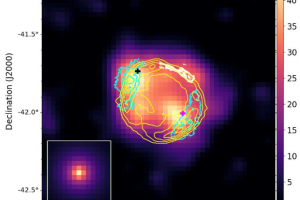Non thermal emission and cosmic rays in the supernova remnants SN1006. The paper: “”Hadronic particle acceleration in the supernova remnant SN 1006 as traced by Fermi-LAT observations” of M. Lemoine-Goumard (University of Bordeaux) appeared on A&A

Supernova remnants serve as unique laboratories to understand the complex processes occurring during a supernova explosion and to investigate the internal structure of massive stars just before their explosive demise. Additionally, the study of these remnants is driven by their crucial role in accelerating cosmic rays, which are particles with extremely high energies. In 1949, Enrico Fermi laid the groundwork for the acceleration theory, which in the 1970s was applied to the powerful shock waves generated by stellar explosions. Key components of this theory include turbulent magnetic fields and dense clouds of interstellar material with which particles interact, both commonly found in supernova remnants.
Evidence of particle acceleration in supernova remnants is sought in high-energy emissions, such as X-rays and gamma rays. Observations in these energy bands aim to identify mechanisms involving charged particles, often grouped under the term “non-thermal emission”. This term distinguishes such radiation from thermal emission, which arises from plasmas at temperatures of millions of degrees. While non-thermal X-ray emission is produced by electrons, gamma-ray emission can originate from either electrons (leptonic emission) or protons (hadronic emission). Since protons are the primary component of cosmic rays, detecting hadronic emission in supernova remnants provides direct evidence of how these astronomical objects effectively produce cosmic rays.
The supernova remnant SN 1006, located about 6.500 light-years from Earth and resulting from a Type Ia supernova (the explosion of a white dwarf in a binary system), is particularly intriguing for studying non-thermal emission. In 1995, it became the first supernova remnant where non thermal X-ray emission was identified, specifically in the southwest and northeast regions. Subsequent X-ray observations have confirmed these findings, revealing critical insights into the role of magnetic fields and the morphology of regions generating non-thermal radiation.
A recent study led by astrophysicist M. Lemoine-Goumard from the University of Bordeaux analyzed 15 years of gamma-ray observations (with energies above 1 GeV) from NASA’s Fermi Gamma-ray Space Telescope. These observations confirmed the presence of very high-energy non-thermal emission in the northeast and southwest regions of SN 1006. Significant differences in emission mechanisms between these areas were observed, primarily due to variations in the density of the material associated with the remnant. In the northeast, the gamma-ray emission is mainly leptonic, whereas in the southwest, direct evidence of hadronic gamma-ray emission was observed for the first time, consistent with predictions from hydrodynamic models. This study confirms that SN 1006 is an efficient accelerator of cosmic rays.
These findings are detailed in the article “Hadronic particle acceleration in the supernova remnant SN 1006 as traced by Fermi-LAT observations“, recently published in Astronomy & Astrophysics. Among the authors is astrophysicist M. Miceli from the University of Palermo and INAF – Palermo Astronomical Observatory.
The cover image (click here to view it in full) displays the map of emission at energies above 1 GeV obtained with the Fermi satellite, covering a 1.5-degree region centered on SN 1006. The black cross marks the position of the source 4FGL J1503.6−4146, while the magenta cross indicates the location of another source discussed in the study. Contours in various colors represent emissions in different bands: cyan indicates gamma-ray emission observed by the H.E.S.S. satellite, white marks Hα radiation (typically associated with gas at temperatures of a few thousand degrees) captured by the 4m Blanco Telescope at Cerro Tololo Inter-American Observatory (CTIO), and yellow shows radio emissions observed with the Murchison Widefield Array (Hurley-Walker et al., 2017). The inset in the lower-left corner illustrates the expected shape of a point source.
Mario Giuseppe Guarcello
Follow MarioSpiegaCose on Instagram () , Facebook (), Youtube (), and X ()
Follow the Astronomical Observatory of Palermo on Facebok and on Instagram
Subscribe the Youtube channel of the Astronomical Observatory of Palermo
